

Tutorial - Creating Fantasy and Science Fiction Worlds. By Michael James Liljenberg.
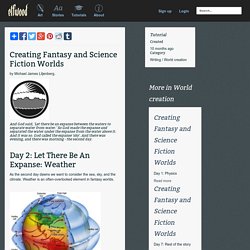
And God said, 'Let there be an expanse between the waters to separate water from water.' So God made the expanse and separated the water under the expanse from the water above it. And it was so. God called the expanse 'sky'. And there was evening, and there was morning - the second day. As the second day dawns we want to consider the sea, sky, and the climate. The interaction of the sea and sky drive our weather systems.
Limyaael Rants Archive - Curiosity Quills Press. Science based - Explaining where energy comes from to power magic - Worldbuilding Stack Exchange. I'm going to try and approach this from the most scientific position I can, so no alternate universes, no mystical crystals, no nothing besides thermodynamics.
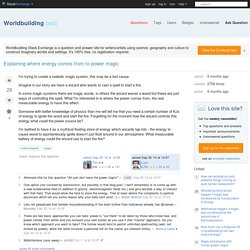
Science based - Sympathy: Give me the chills! - Worldbuilding Stack Exchange. Burst: Energy As Isaac already pointed out, we can get a pretty good approximation of a mage's heat capacity using just the heat capacity of water (since pretty much all of our tissues are mostly water).
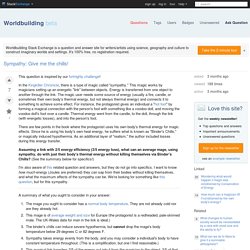
This gives us a maximum energy burst of: Draw: Power Although the burst energy is interesting, there's still a crucial factor missing: we don't know if "recharging" a mage's internal heat reservoir takes seconds or hours. As a rough estimate, the amount of heat generated by the average male is around . Assuming that heat is generated at while recharging, and that heat loss is roughly proportional to temperature (with standard body temperature corresponding to of heat output), we get an equation like this: That means that peak burst power represents the better part of a day's reserve, unless your mage takes the time to warm himself by the fire (which can deliver a significant amount of heat).
But hold on a second... what if you can augment your internal heat with environmental heat? Summary. Assuming magic is a source of energy that wizards have access to, how would they "bleed off" the energy when not using it? - Worldbuilding Stack Exchange. Science based - Evolution of a creature that uses light as a weapon - Worldbuilding Stack Exchange. This first part is sort of a wind up, skip to The Good Part for the good part.
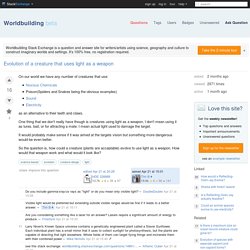
As other posters have said before light isn't a very good weapon. But they haven't explained why that is. Science based - How would a Reflecting-Oven-Jay Evolve? - Worldbuilding Stack Exchange. A baby male African jay bird hatches from its egg.

In addition to its colorful feathers, one of its tail feathers has a reflective quality. It could be because this family of birds has had a diet with more aluminum in it than normal, and has adapted to it. Regardless of mutation that caused this reflective pigment to appear, some feathers on this new bird do not absorb any light. Now, this doesn't make the bird live any longer, or get any stonger, in itself. But let me tell you - he is a hit with the ladies. Anti-predator adaptation. Anti-predator adaptation in action: the seal shark Dalatias licha (a–c) and the wreckfish Polyprion americanus (d–f) attempt to prey on hagfishes.
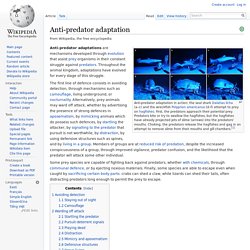
First, the predators approach their potential prey. Predators bite or try to swallow the hagfishes, but the hagfishes have already projected jets of slime (arrows) into the predators' mouths. Choking, the predators release the hagfishes and gag in an attempt to remove slime from their mouths and gill chambers.[1] Anti-predator adaptations are mechanisms developed through evolution that assist prey organisms in their constant struggle against predators.
Throughout the animal kingdom, adaptations have evolved for every stage of this struggle. The first line of defence consists in avoiding detection, through mechanisms such as camouflage, living underground, or nocturnality. Avoiding detection[edit] Staying out of sight[edit] Main article: nocturnality. Science based - What efficiencies make a realistic food chain? - Worldbuilding Stack Exchange. The 10% conversion efficiency mentioned in other answers is a decent rule of thumb — there's a lot of variation in the real world, but if you assume that the total prey biomass equals somewhere around 10 times the total predator biomass, you'll get a fairly plausible-looking food chain.

Tim B makes an excellent point in the comments, though: generally, even apex predators mostly hunt herbivores, simply because they're usually the easiest and most abundant food source around. So a 100 kg apex predator does not need 1,000 kg of lower predators to support it — it just needs 1,000 kg of some kind of prey, which may include both herbivores and other carnivores. In fact, in real life, many apex predators (such as bears and, indeed, humans) are even omnivorous to some extent, consuming some plants (usually parts with high nutritive value, like fruits, nuts and berries) to supplement their hunting. Worldbuilding. Worldbuilding or conworlding is the process of constructing an imaginary world, sometimes associated with a whole fictional universe.[1] The resulting world may be called a constructed world.
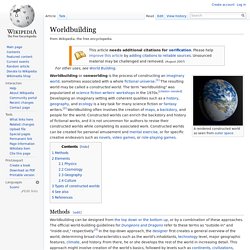
The term "worldbuilding" was popularized at science fiction writers' workshops in the 1970s. [citation needed] Developing an imaginary setting with coherent qualities such as a history, geography, and ecology is a key task for many science fiction or fantasy writers.[2] Worldbuilding often involves the creation of maps, a backstory, and people for the world. Constructed worlds can enrich the backstory and history of fictional works, and it is not uncommon for authors to revise their constructed worlds while completing its associated work. Constructed worlds can be created for personal amusement and mental exercise, or for specific creative endeavors such as novels, video games, or role-playing games. Methods[edit] Elements[edit] 30 Days of WorldBuilding. By popular demand, you can now download the Magical WorldBuilder Guide in three easy-to-carry (non-DRM) formats: PDF for printing out at home or reading on a computerePub for use with many fine ereader devicesMOBI for use with Kindles and MobiPocket software.As of 2007, The world-builder exercises are licensed under a Creative Commons license to help you in deciding whether you can translate (yes, with credit back), distribute to your writing group (yes, with credit), sell (not without permission), reprint (yes, for non-commercial purposes), or mirror (yes, with credit back) this useful guide!
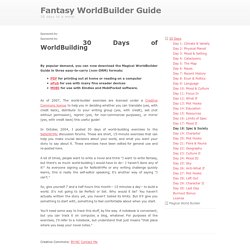
In October, 2004, I posted 30 days of world-building exercises to the NaNoWriMo discussion forums. These are short, 15-minute exercises that can help you make crucial decisions about your world, and what you want your story to say about it. Berley’s Top 10 World Building Tips for Sci Fi or Fantasy. Like I have mentioned in past blog posts, it took me ten years of writing and collecting rejection letters to get to level I am today.
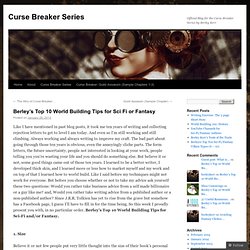
And even so I’m still working and still climbing. Always working and always writing to improve my craft. The bad part about going through those ten years is obvious, even the annoyingly cliche parts. The form letters, the future uncertainty, people not interested in looking at your work, people telling you you’re wasting your life and you should do something else. A Way With Worlds - Entire Column Listing. A Way With Worlds - Entire Column Listing. Criar Mundos - Entrada. World Dream Bank: PLANETOCOPIA. 6 wild and crazy sci-fi abilities of real-life plants. Plants don't get enough respect as sci-fi monsters. Sure, Triffids will always rule, but sci-fi baddies tend to be mutants, zombies, vampires and other altered mammals. 12 bizarre real-life plants that look like sci-fi alien monsters. Are plants the missing link between ancient astronauts and Earth? One look at these freaks of nature is enough to convince us.
We combed the planet to find 12 plants that make the horrific Day of the Triffids look as tame as The Happening.
Strolen's Citadel: A Role Playing Community. 30 Days of WorldBuilding. By popular demand, you can now download the Magical WorldBuilder Guide in three easy-to-carry (non-DRM) formats: PDF for printing out at home or reading on a computerePub for use with many fine ereader devicesMOBI for use with Kindles and MobiPocket software.As of 2007, The world-builder exercises are licensed under a Creative Commons license to help you in deciding whether you can translate (yes, with credit back), distribute to your writing group (yes, with credit), sell (not without permission), reprint (yes, for non-commercial purposes), or mirror (yes, with credit back) this useful guide!
In October, 2004, I posted 30 days of world-building exercises to the NaNoWriMo discussion forums. 10 Steps to Creating Realistic Fantasy Animals. By Ashley Lange Why do writers write? Themes & Things To Keep In Mind When Writing Fantasy Stories and Adventures » Daily Encounter. This list is far from complete. Maps of Mastery. Worldbuilding. Authors Guide To Drawing Maps - The World Building School. Basics Of Maps The articles included in this part of the guide will teach you basic principles about how our world works and show you how to implement these principles into your own world. World Building Articles. Over 247 Deviants Watch The World Builders Guild. Ed: As of 18/11/2013 we have 995 watchers! The World Builders Guild is a DeviantART group that is dedicated to collecting great artwork that will inspire world building. If you’v never heard of DeviantART then it is the top website for artists – think of it as Facebook for artwork, but it was around long before Facebook ever came into being.
So the members of The World Builders Guild are made up of artists and writers who enjoy creating and writing about fantasy worlds they have created. The Guild features artwork from some of the most skilled artists on DeviantART. The gallery is split up into a number of folders to help you find art that will inspire your world. Featured Cartography Environments Creatures Characters Armour Design Vehicles Map Resources. Magical World Builder. By, Stephanie Cottrell Bryant. Creating Fantasy Nations (World Building II) By this point you've got your map and the basics for one of your ideas. It's time to put people on these continents. If you haven't already, ask yourself the basics about each culture you want to generate. Taken from World Building I, those are: What are the needs of this culture?
(Consider food, building materials, technologies and the position you'd like it to take in the rest of the world - eg. weak cultures require power relations to become stable. Creating Fantasy and Science Fiction Worlds - Day 0. Creating a Realistic Fantasy World. By Penny Ehrenkranz Did you ever wonder how David Eddings, Terry Brooks, Orson Scott Card, Stephen King, Piers Anthony, or J. R. R. Tolkien created their worlds? World Building 101. World Building 101 by Lee Masterson. Games: Roleplaying: World Building. CBG Wiki - The CBG Wiki.